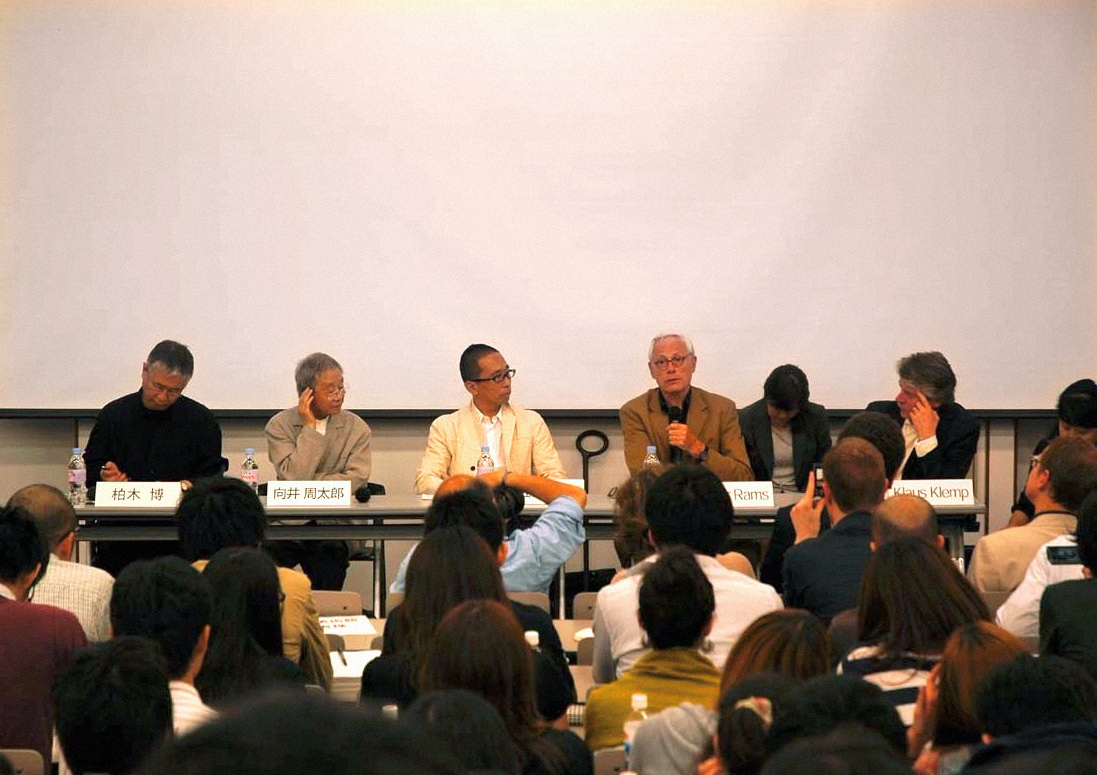Lecture of the Tokyo Manifesto during the symposium of the Tokyo Musashino Art University on the occasion of the exhibition opening Less and More on 23 May 2009 with Hiroshi Kashiwagi, Shutaro Mukai, Taku Satoh, Dieter Rams and Klaus Klemp (from left to right)
Photo: Keiko Ueki-Poulet © rams foundation
Tokyo Manifesto
As part of the Less and More exhibition in Tokyo, Dieter Rams addressed an appeal to young designers that reflects his attitude to design
Dieter Rams
On the occasion of an extensive retrospective in Japan about my work as a designer of many years I would like to take the opportunity to define my viewpoint on design, in particular addressing the young designers amongst us.
The world of tomorrow will be designed by the students of today. As with every young generation of its time, responsibility, but also great opportunity, rests upon them.
As a product designer and university professor for over 40 years I was able to be a part of this process when my own young generation. It was also us who wanted, in those days, to live in a different world with better products. Designers should always have the ambition to change the world for the better; it cannot happen by itself. In those days we had been challenged by the austerity of the post-war years. Today’s big challenges are to protect our natural environment and to overcome thoughtless consumerism.
I would like to encourage the young designers of tomorrow to be self-confident and audacious and ready to take risks. I would also like to invite them to come up with new proposals – not the obvious and the fashionable, but the truly better ones. A long while back I put down ten commandments – principles which we should continue to work on. For me good design is innovative, useful, aesthetic, understandable, unobtrusive, honest, durable, thorough to the last detail, concerned with the environment and, last but not least, achieved with as little design as possible. Very good design, however, does not evolve only by ticking those ten boxes. From a good, ordinary design there should always be the possibility for an outstanding, self-explanatory design to arise. It very seldom happens. Such outstanding products and their aura of being close to perfection are an essential stimulus to encourage how we design our environment. They are the benchmark for the future.
When I was working I was lucky to be surrounded by innovative people who were willing to take risks. It was not just accident that brought us together, rather the same way of imagining this other world. We wanted to make products that did not attract attention at first sight but which convinced when in use via a long-living aesthetic.
There are many new challenges on the shoulders of the designers of tomorrow. It is no longer only about the product, but also about the infrastructure that surrounds products. This will require an ethos exempt from indifference and arbitrariness. Our precarious environmental situation and an instable global economy demand a new attitude to products. We should think twice about what we would want to produce. Less is only more if it is also better. This is what the design students of today will have to solve when they are soon working as professionals.
Branding and designing brands will not be enough. An excessive hype about brands has distracted from the original, true qualities of products and opened up the market for cheap, fake offers where the true or false label became more important than the product itself.
Designers have to worry about an all-embracing quality of their realised ideas. Design therefore begins with consideration. The starting point for a new way of seeing design can happen here in Japan. Engaging with this country’s traditions and making use of them as a stimulus for the future – such as the ancient Zen Bhuddism or the Wabi-Sabi – could revive our world of products. To follow the thoughts on modesty or frugality for a certain time could be the beginning of an altogether new understanding of products.
A new way of handling our products and resources could be liberating, leading to a new, content way of living. Products that are durable, intelligent, useful and conscious of the environment can evoke a much deeper fulfillment. This new design does not have to be boring but, quite the contrary, it could be very exciting.
A culturally interlinked, media-experienced, media-driven and knowledgeable future generation of designers will be able to avoid the mistakes of today and sally forth for better ways. I would like to encourage my young colleagues to do so.
(2009)




